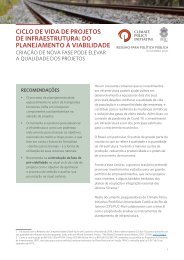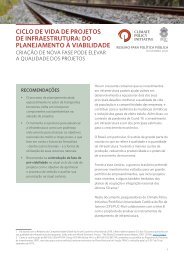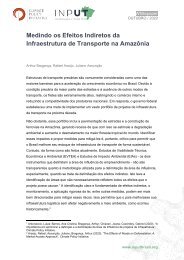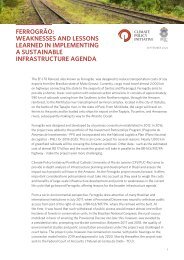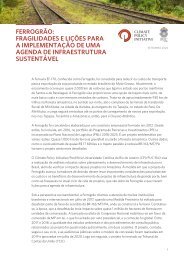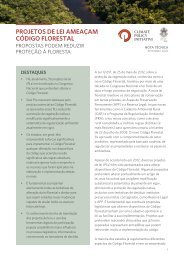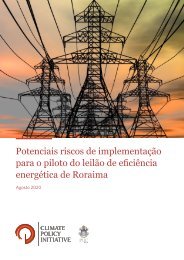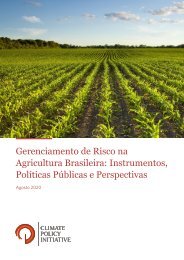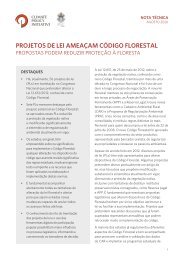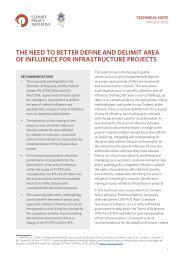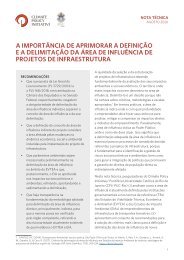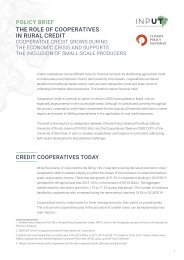Report - Risk Management in Brazilian Agriculture
You also want an ePaper? Increase the reach of your titles
YUMPU automatically turns print PDFs into web optimized ePapers that Google loves.
Executive Summary<br />
BOX 1. BRAZIL’S RISK MANAGEMENT INSTRUMENTS<br />
Brazil’s agricultural producers can access crucial risk management <strong>in</strong>struments and count on<br />
relevant <strong>in</strong>surance programs offered by the government. However, these <strong>in</strong>struments and<br />
programs are limited <strong>in</strong> size and scope and do not provide the range of risk management<br />
options for producers to make decisions that lead to efficient farm<strong>in</strong>g practices. Figure 1<br />
shows the ma<strong>in</strong> risk mitigation <strong>in</strong>struments <strong>in</strong> Brazil <strong>in</strong> 2018. Among the total amount of<br />
rural <strong>in</strong>surance premiums 4 <strong>in</strong> SUSEP <strong>in</strong> 2018 (R$4.6 billion), R$2.1 billion represents crop,<br />
livestock, or forest <strong>in</strong>surance, which are categories potentially eligible for subsidies <strong>in</strong> the<br />
scope of the Rural Insurance Premium Subsidies Program (Programa de Subvenção ao Prêmio<br />
do Seguro Rural - PSR). Of those R$2.1 billion <strong>in</strong> 2018, R$856 million were subsidized by PSR.<br />
The total subsidy amount was R$367 million, and the production value <strong>in</strong>sured was R$12.3<br />
billion. For the same year, the <strong>in</strong>surance premiums subsidized by the Agricultural Activity<br />
Guarantee Program (Programa de Garantia da Atividade Agropecuária - PROAGRO) - a rural<br />
<strong>in</strong>surance that protects producers from losses caused by natural events and covers f<strong>in</strong>ancial<br />
obligations related to rural credit for operational costs - were R$377.2 million. The total<br />
production value covered under this program reached R$13.4 billion. The Harvest Guarantee<br />
Program (Garantia-Safra), a program to support family farm<strong>in</strong>g affected by losses caused<br />
by droughts and floods, paid R$444 million <strong>in</strong> the agricultural year 2017/18. F<strong>in</strong>ally, the<br />
M<strong>in</strong>imum Price Guarantee Policy (Política de Garantia de Preços Mínimos - PGPM), a program<br />
to correct price distortion to producers, paid R$47 million <strong>in</strong> 2018.<br />
Figure 1. Structure of <strong>Agriculture</strong> <strong>Risk</strong> Mitigation Instruments <strong>in</strong> Brazil, 2018<br />
Note: Data <strong>in</strong>clude all types of rural <strong>in</strong>surance. All data on <strong>in</strong>surance programs and subsidies correspond to the<br />
2018 calendar year, with the exception of Garantia-Safra that corresponds to the 2017/18 agricultural year.<br />
Source: Climate Policy Initiative with data from MAPA, SUSEP, and SICOR<br />
<strong>Risk</strong> management programs historically receive considerably fewer public resources than<br />
rural credit programs. Nearly R$225.6 billion were allocated to rural credit programs <strong>in</strong> the<br />
2019/20 agricultural year through the Crops and Livestock Plan (Plano Agrícola e Pecuário<br />
- PAP) and the National Plan for Family Farm<strong>in</strong>g (Programa de Fortalecimento da Agricultura<br />
Familiar - PRONAF). The cost of subsidies to rural credit programs is estimated to be<br />
approximately R$10 billion per year. By comparison, accord<strong>in</strong>g to the Central Bank of Brazil,<br />
the National Treasury allocated R$161.5 million to PROAGRO <strong>in</strong> 2018. Also, the average<br />
subsidy of PSR from 2010 to 2019 was around R$383.6 million. However, for the 2019/20<br />
and the 2020/21 agricultural years, <strong>in</strong>creases <strong>in</strong> PSR fund<strong>in</strong>g were announced, reach<strong>in</strong>g R$1.0<br />
billion and R$1.3 billion, respectively.<br />
4 Total premium values are the net premium (what is paid by producers) plus government subsidies.<br />
3




